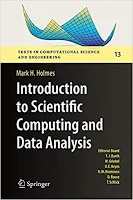Mastering MATLAB: A Comprehensive Journey Through Coding and Analysis
Kameron Hussain; Frahaan Hussain ... 220 pages - Publisher: Independently Published; (January, 2024) - Language: English.
Dive into the world of MATLAB with "Mastering MATLAB: A Comprehensive Journey Through Coding and Analysis," a definitive guide designed for both beginners and experienced users. This book serves as an invaluable resource for engineers, scientists, and anyone interested in harnessing the power of MATLAB for numerical computation, data analysis, and algorithm development. Starting with the basics, the book introduces you to the MATLAB environment, guiding you through its user-friendly interface and powerful tools. You'll learn to write clean, efficient MATLAB code, with a focus on understanding syntax, functions, and the extensive libraries available. Each chapter builds upon the last, ensuring a gradual and solid grasp of concepts.
"Mastering MATLAB" is more than just a programming guide; it's a practical handbook for real-world applications. Delve into chapters dedicated to data visualization, matrix manipulations, and statistical analysis, all crucial for data-driven projects. You'll encounter detailed examples and exercises that demonstrate how MATLAB can solve complex problems in engineering, science, and mathematics. For advanced readers, the book delves into sophisticated topics such as GUI development, machine learning applications, and integrating MATLAB with other programming languages. This section is particularly beneficial for professionals seeking to elevate their coding prowess and integrate MATLAB into their workflow for more efficient problem-solving and research.
Every concept is explained in-depth, accompanied by illustrative examples, making complex ideas accessible. Whether you're a student needing a comprehensive academic resource, a professional aiming to enhance your technical skillset, or a hobbyist eager to explore computational mathematics, "Mastering MATLAB" is your go-to guide. Embrace the journey of mastering MATLAB and unlock a world of possibilities in coding and analysis.
Dive into the world of MATLAB with "Mastering MATLAB: A Comprehensive Journey Through Coding and Analysis," a definitive guide designed for both beginners and experienced users. This book serves as an invaluable resource for engineers, scientists, and anyone interested in harnessing the power of MATLAB for numerical computation, data analysis, and algorithm development. Starting with the basics, the book introduces you to the MATLAB environment, guiding you through its user-friendly interface and powerful tools. You'll learn to write clean, efficient MATLAB code, with a focus on understanding syntax, functions, and the extensive libraries available. Each chapter builds upon the last, ensuring a gradual and solid grasp of concepts.
"Mastering MATLAB" is more than just a programming guide; it's a practical handbook for real-world applications. Delve into chapters dedicated to data visualization, matrix manipulations, and statistical analysis, all crucial for data-driven projects. You'll encounter detailed examples and exercises that demonstrate how MATLAB can solve complex problems in engineering, science, and mathematics. For advanced readers, the book delves into sophisticated topics such as GUI development, machine learning applications, and integrating MATLAB with other programming languages. This section is particularly beneficial for professionals seeking to elevate their coding prowess and integrate MATLAB into their workflow for more efficient problem-solving and research.
Every concept is explained in-depth, accompanied by illustrative examples, making complex ideas accessible. Whether you're a student needing a comprehensive academic resource, a professional aiming to enhance your technical skillset, or a hobbyist eager to explore computational mathematics, "Mastering MATLAB" is your go-to guide. Embrace the journey of mastering MATLAB and unlock a world of possibilities in coding and analysis.



















